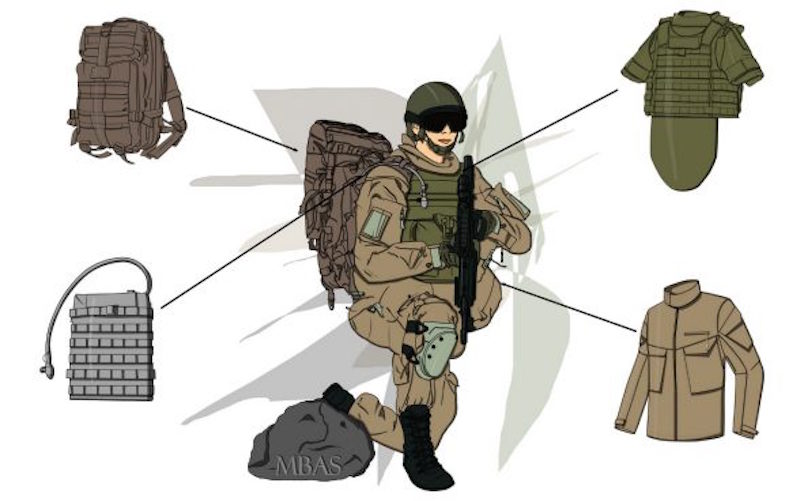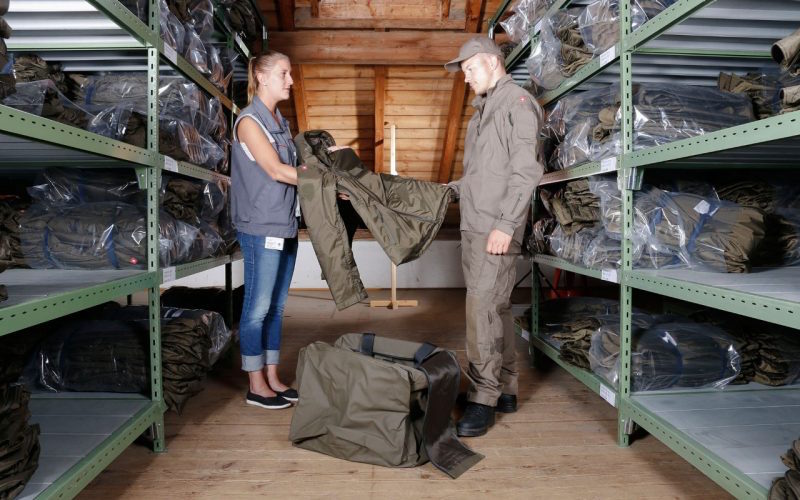Hol Dir den wöchentlichen SPARTANAT-Newsletter.
Dein Bonus: das gratis E-Book von SPARTANAT.

Projekt MBAS: Und wer hats erfunden? Die Schweizer …
Auch Armeen müssen mit der Zeit gehen: In der Schweiz dreht sich da das Rad gerade ein großes Stück weiter mit einem großen Beschaffungsvorhaben. Die aktuell in der Nutzung stehende, bewährte Kampfbekleidung 90/06 mit der dazugehörigen Grundtrageinheit, als auch die Schutzweste 96 sollen abgelöst werden.
Auch Armeen müssen mit der Zeit gehen: In der Schweiz dreht sich da das Rad gerade ein großes Stück weiter mit einem großen Beschaffungsvorhaben. Die aktuell in der Nutzung stehende, bewährte Kampfbekleidung 90/06 mit der dazugehörigen Grundtrageinheit, als auch die Schutzweste 96 sollen abgelöst werden. Mit einem modularen Bekleidungs- und Ausrüstungssystem für militärische Einsätze (MBAS) soll der Angehörige der Schweizer Armee in aktuellen und künftigen militärischen Einsätzen bei der Auftragserfüllung unterstützt werden.
Im Juli 2017 startete der Truppenversuch, welcher bis Februar 2018 andauert. Er hat zum Ziel, das System MBAS im täglichen Einsatz auf seinen Nutzen bzw. Mehrwert hin zu prüfen und die Truppentauglichkeit in der Praxis zu beurteilen. Der Truppenversuch wird mit ca. 350 Angehörigen der Armee aus insgesamt 13 Lehrverbänden bzw. Kompetenzzentren durchgeführt.
Getestet wird das MBAS in seiner Ausführung als Basissystem (Kampfbekleidung, Tragsystem, ballistischer Körperschutz, Trinksystem). Nach Abschluss des Truppenversuchs werden die gewonnenen Erkenntnisse analysiert und beurteilt und bilden die Basis für den Entscheid der Truppentauglichkeit. Das alles geht bei den Schweizern recht flott: Das System ist vorgesehen für das Rüstungsprogramm 19. Die Einführung ist ab 2022 geplant.
Projekt MBAS
„Modularität“ ist das zentrale Schlagwort in der Anforderung an das neue System: das modulare Bekleidungs- und Ausrüstungssystem für militärische Einsätze (MBAS) ist aber wenig anderes als eine komplette, zeitgemäße Neuaufstellung der Mannesausrüstung für den Schweizer Soldaten. Generelle Vorgaben für die Entwicklung:
- Ergonomische Schnittform, dadurch wird der Tragkomfort erhöht. Dies unterstützt die Leistungsfähigkeit des Soldaten.
- Neues optimiertes Grössensystem. Dies hat eine Reduktion der Anzahl Grössen zur Folge und somit kann die Lagerhaltung optimiert werden. (z.B. Tarnanzug-Hose um etwa die Hälfte).
- Die einzelnen Schichten (z.B. Tarnanzug, Regenschutz und Kälteschutz) sind aufeinander abgestimmt.
- Durchgehendes Grössensystem aller Ausrüstungsteile MBAS. Die Abgabe soll damit vereinfacht werden.
- Der Kälteschutz ist für statische Einsätze bei Temperaturen bis zu -15°C ausgelegt.
Bei der Trageweste, Rucksäcke und Schutzweste sind folgende Verbesserungen vorgesehen:
- Einführung eines Trinksystems (vergleichbar wie Camelback) zusätzlich zur eingeführten Feldflasche.
- Ballistischer Schutz als Ersatz für die Schutzweste 96: Leichter Plattenträger mit wesentlich leichteren ballistischen Schutzplatten. Unter anderem hat der Anwender die Möglichkeit der Lastenverteilung von den Schultern auf die Hüften durch ein Verbindungselement zum Hüftgurt.
- Rucksäcke: Höhenverstellbar entsprechend Körpergrösse, Lastenverteilung von Schulter auf Hüfte durch einen an den Rucksack angebrachten Hüftgurt
- Modularität: Alle Artikel sind mit dem gleichen Bänderungssystem zur Befestigung von Taschen ausgestattet.
Das MBAS beinhaltet vier Subsysteme:
- Kampfbekleidung: Bestehend aus Unterwäsche, Tarnanzug (Sommer- und Winterversion), Wind-, Regen- und Kälteschutz.
- Tragsysteme: Bestehend aus verschiedenen Tragvorrichtungen (Traggurt, Tragweste, und/oder ChestRig), unterschiedlich großen Rucksäcken und einem dazugehörigen Taschensatz.
- Ballistischer Körperschutz: Bestehend aus einem Plattenträger (reduzierte Schutzfläche; Einsatz bei hoher physischer Belastung/Beweglichkeit) als auch einer klassischen Schutzweste mit dazugehörigem Kragen und Unterleibsschutz (maximale Schutzfläche; Einsatz bei normaler physischer Belastung/statischen Einsätzen).
- Trinksystem: Bestehend aus Wasserbeutel, Trinkschläuchen und verschiedenen Adaptern für PET-Flaschen.
MBAS bringt eine hohe Modularität die Ausrüstung:
- Das bereits eingeführte und bewährte „Zwiebelschalenprinzip“ der Kampfbekleidung wird beibehalten, sodass der Nutzer seine Bekleidung individuell den Temperatur- und Witterungsverhältnissen anpassen kann.
- Auch können die einzelnen Taschen mit Hilfe eines Bänderungssystems – international MOLLE genannt – einsatzspezifisch montiert und getragen werden (wahlweise an einer Tragvorrichtung, einem Rucksack, einem Plattenträger oder einer Schutzweste).
Einführung nach Truppenversuch
Im Rahmen von zwei Versuchsreihen (Prinzipversuche) mit einer 15-köpfigen Probandengruppe bestehend aus Berufsmilitärs konnte eine Reduktion auf ein bis zwei Varianten pro Subsystem erreicht werden.
Mit dem Truppenversuch bis Februar 2018 wird MBAS im täglichen Einsatz auf seinen Nutzen bzw. Mehrwert geprüft und die Truppentauglichkeit des Systems in der Praxis letztendlich beurteilt. Getestet wird das MBAS in der Ausführung „Basissystem“, welches zu einem späteren Zeitpunkt für Spezialfunktionen angepasst oder ergänzt werden kann. Im Truppenversuch werden alle Komponenten in unifarben getestet. Mit Einführung erfolgt dann für einen Grossteil der Ausrüstungsgegenstände die Umstellung auf das Schweizer Multiumfeldtarnmuster 16. Das Tarnmuster ist neu und gilt für die ganze Schweizer Armee und nicht nur für das Projekt MBAS. Das Design hat nicht geändert, sondern nur die Farben. Die Farben Schwarz und Oliv sind durch Brauntöne ersetzt worden. Damit ist der Gesamteindruck leicht heller und leicht brauner und entspricht besser dem Umfeld.
Im Truppenversuch werden alle Komponenten in unifarben getestet. Mit Einführung erfolgt dann für einen Grossteil der Ausrüstungsgegenstände die Umstellung auf das Schweizer Multiumfeldtarnmuster 16. Das Tarnmuster ist neu und gilt für die ganze Schweizer Armee und nicht nur für das Projekt MBAS. Das Design hat nicht geändert, sondern nur die Farben. Die Farben Schwarz und Oliv sind durch Brauntöne ersetzt worden. Damit ist der Gesamteindruck leicht heller und leicht brauner und entspricht besser dem Umfeld.
ARMA SUISSE im Internet: www.ar.admin.ch
SPARTANAT ist das Online-Magazin für Military News, Tactical Life, Gear & Reviews.
Schickt uns eure News: [email protected]
Werbung
Hol Dir den wöchentlichen SPARTANAT-Newsletter.
Dein Bonus: das gratis E-Book von SPARTANAT.


